Having one of the best generations in their history, Portugal have qualified for the 2022 World Cup via the playoffs — after having been beaten by Serbia in the decisive match for the top spot of the group that guarantees qualification directly to the tournament. However, they would beat Macedonia days later in the playoff match and are once again at the most prestigious tournament in the world.
With bags of history on their backs, including names like Luís Figo, Rui Costa and the achievement at the 2006 World Cup where they finished in fourth place, Portugal are looking forward to shocking the football fans as they did back in the 2016 European Championship where they didn’t play the most beautiful football, yet managed to be the most solid at the back, allowing them to celebrate their first major title. This time, they arrive with a younger and still very talented team.
Fernando Santos has developed a mentally strong squad with belief and the ability to win everything since his arrival in 2014. The team has been living through a tough present where ideas are not connecting in the best way, but the quality of the team is always there, and of course, the legendary Cristiano Ronaldo is still present.
This scout report in the form of a tactical analysis will provide a detailed insight into Portugal’s tactics under Fernando Santos. More specifically, this analysis aims to identify why and how Portugal come into this World Cup as one of probable shocks.
Predicted starting XI
Portugal often play with a 4-2-3-1 with different types of wingers on each side, a single striker and, behind, a ‘10’. Deeper, they use a double-pivot with one of them as a box-to-box and a rough back-four that possess the technical ability to find attacking players in dangerous positions while locking down their own box, as well as pacey players to defend rapid transitions.
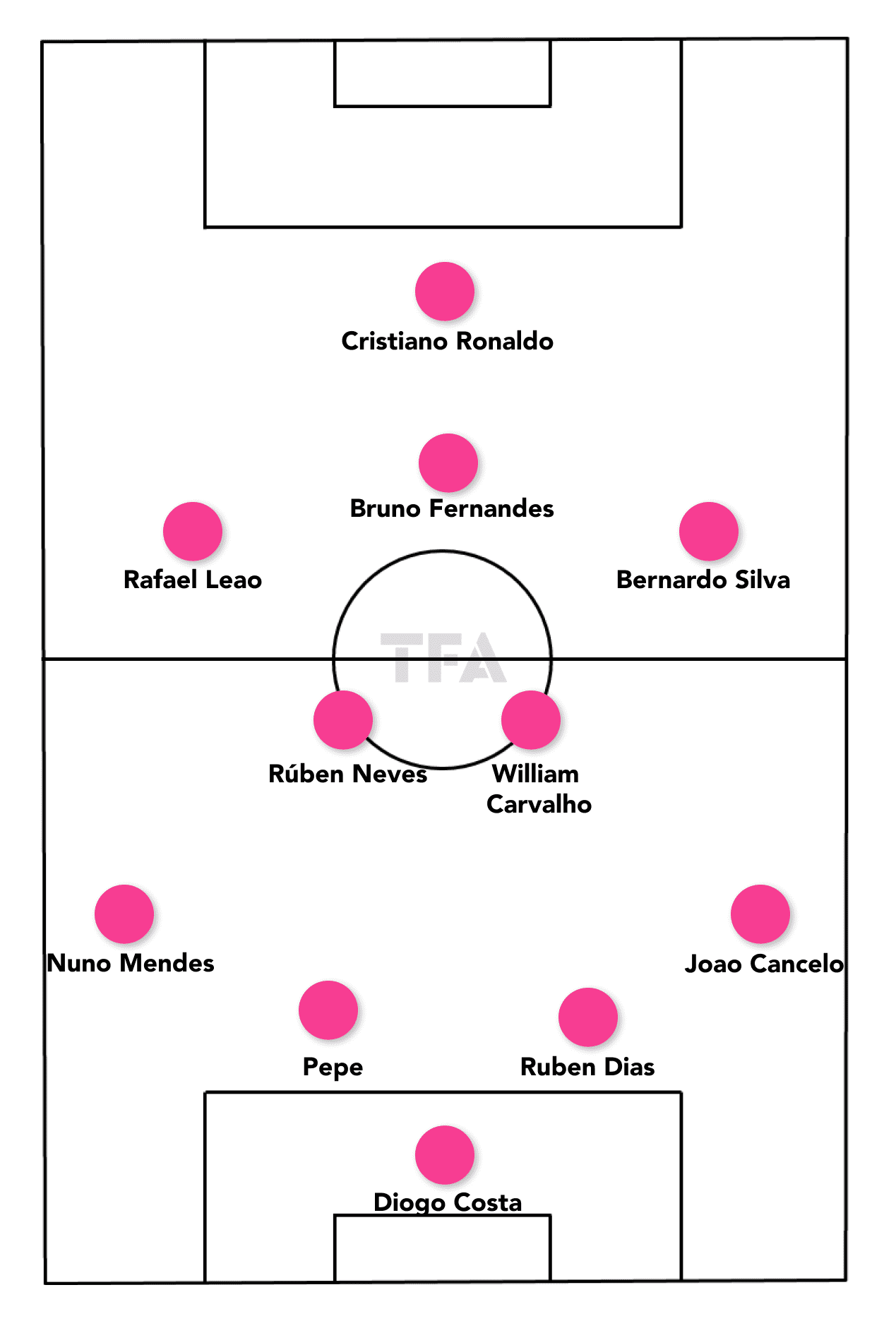
Diogo Costa, Porto’s young goalkeeper, has earned his rightful spot in the national team lately, thanks to his incredible performances domestically and at international level. Pepe, at 38 years of age, is still one of the regular starters for Fernando Santos thanks to his defensive solidity as well as his underrated passing abilities, always accompanied by Rúben Dias.
Nuno Mendes and João Cancelo, without any doubt, are going to be Santos’ full-backs, each offering a very different profile, similar to the wingers Rafael Leão and Bernardo Silva. Rúben Neves and William Carvalho have settled in perfectly, combining balance and intelligent roles on the ball, finishing with Bruno Fernandes as a ‘10’ and Cristiano Ronaldo up front.

Attacking phase
Santos’ Portugal varies from a direct team that likes to build up attacks from the back and arrive in the final third in three-to-five touches, to a pragmatic one that likes to sit in a solid and rigid mid-block that doesn´t allow rivals to be effective with their ball-dominance throughout the match.
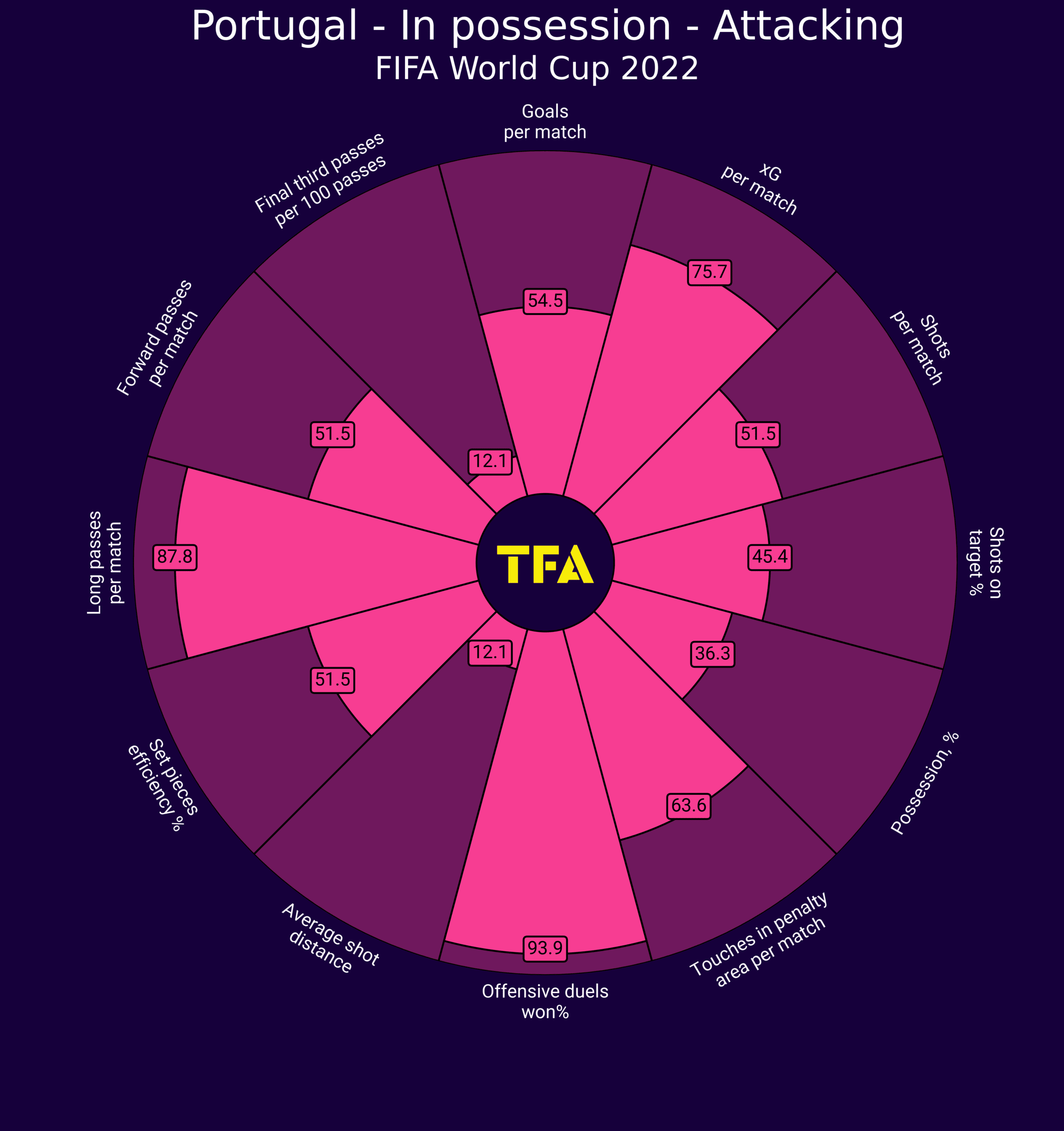
Players like Bernardo Silva and William Carvalho play pivotal functions inside the team system, thanks to their off-the-ball movements and approaches in the base of the plays, as Silva likes to accomplish.
Portugal like to serve the ball from Diogo Costa to the centre-backs with a great capacity to find teammates between the lines. Normally, the right-back plays inverted and joins the back-three or the midfield to free up Carvalho (box-to-box) to move to more advanced areas and open space on the wing for Bernardo or Bruno to pin that zone. This is one of the first impressions the ‘Lusos’ give when on the ball.
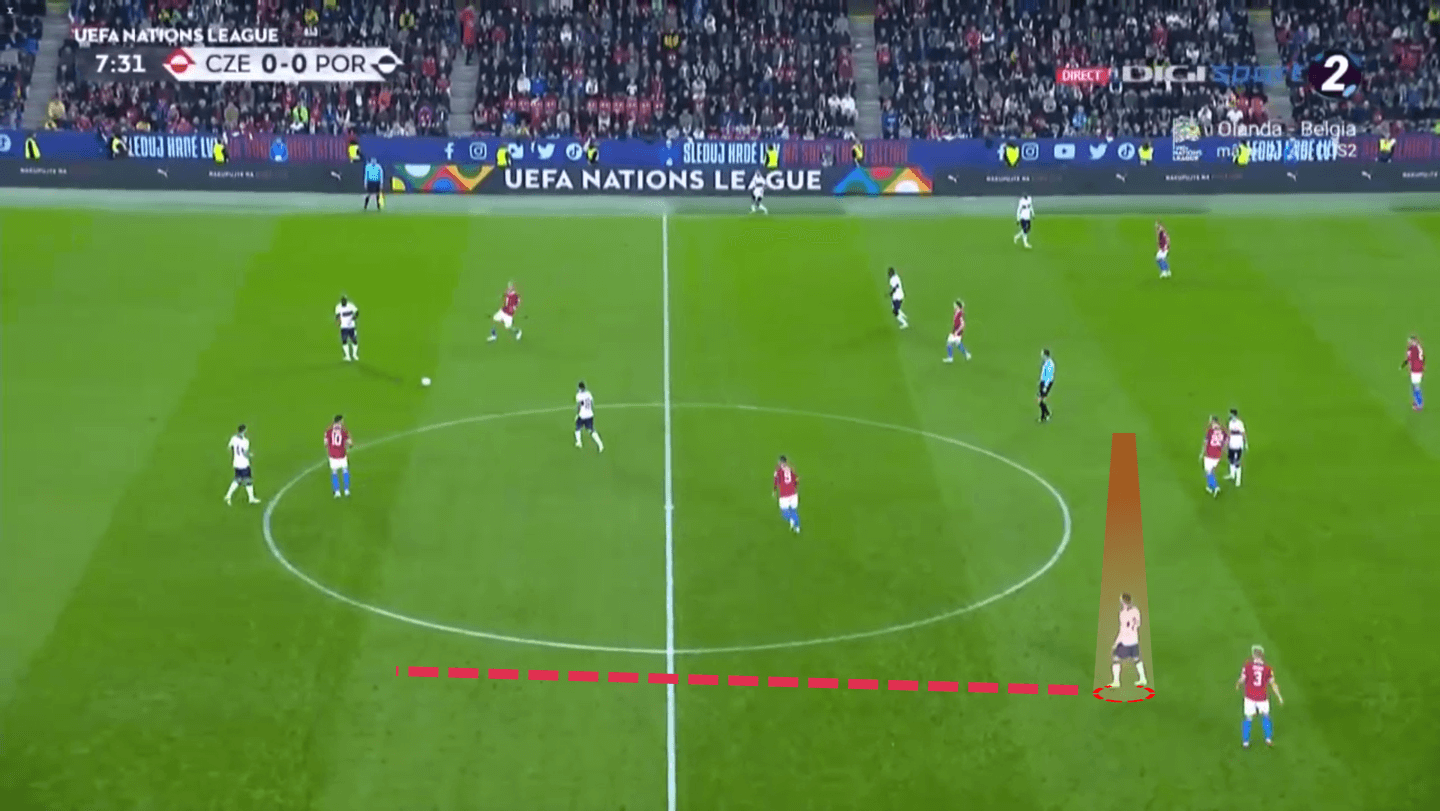
In the first stage of the build-up, the movements of the box-to-box, usually William Carvalho, are vital to open spaces for Rúben Neves or centre-backs to break lines, as he tries to drag rival players to wide areas where inverted wingers or the ‘10’ can receive.
This is one of the key functions, as Portugal likes to be very rapid from the back and not stay too long with the ball in their own third or between the back-four, as they want to create chaos in the opposition area. Carvalho, then, with his mobility, keeps helping the team to find spaces off the ball.
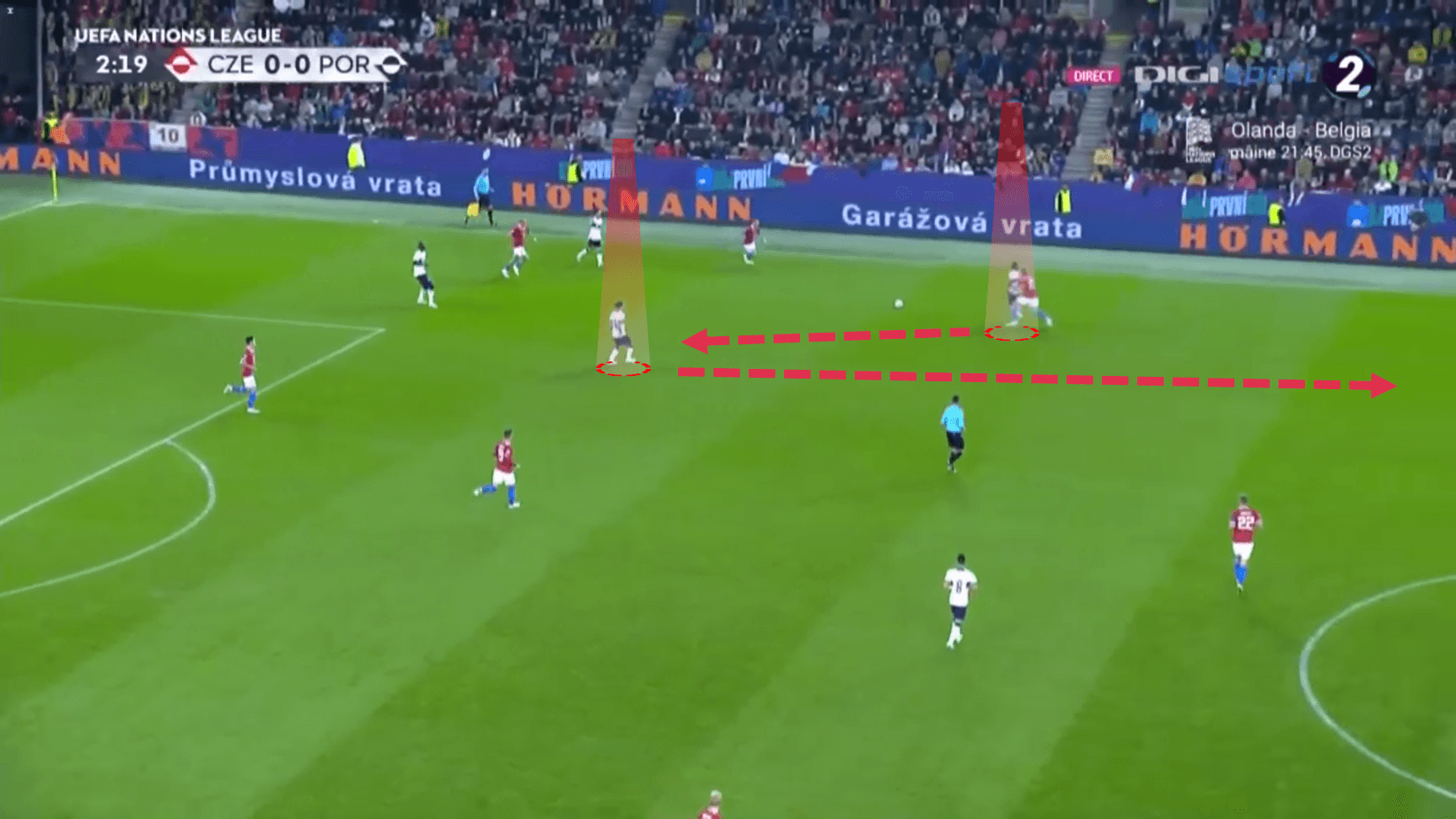
Another method used by Portugal to skip steps to get into an attacking phase is the great long distribution Diogo Costa possesses. This sees Portugal usually trying to strike long passes to the left side of the pitch where Cristiano Ronaldo and the left-winger can do several exchanges to confuse markers and then run in behind them.
Bernardo Silva’s role is also a key part of the build-up in Portugal. Just as in his role with Manchester City, he likes to get very deep and play in the double-pivot, where he can retain the ball for long seconds to find the best passing option, through his great turns and dribbling ability.
In the middle third, rotations and overloads are seen commonly on the right side, where Bruno Fernandes and Bernardo Silva tend to change positions and channels constantly, as well as the arrival of the full-back through the middle — normally João Cancelo.
This is another example of how Portugal try to beat low blocks and pressures very quickly, creating overloads to execute one-two situations and arrive at the box. On the left side, Cristiano Ronaldo and his winger usually change positions, looking to free one of them between the middle or outside. In this example, we can see Bruno almost hugging the line, and Bernardo acting as the free man through the middle.
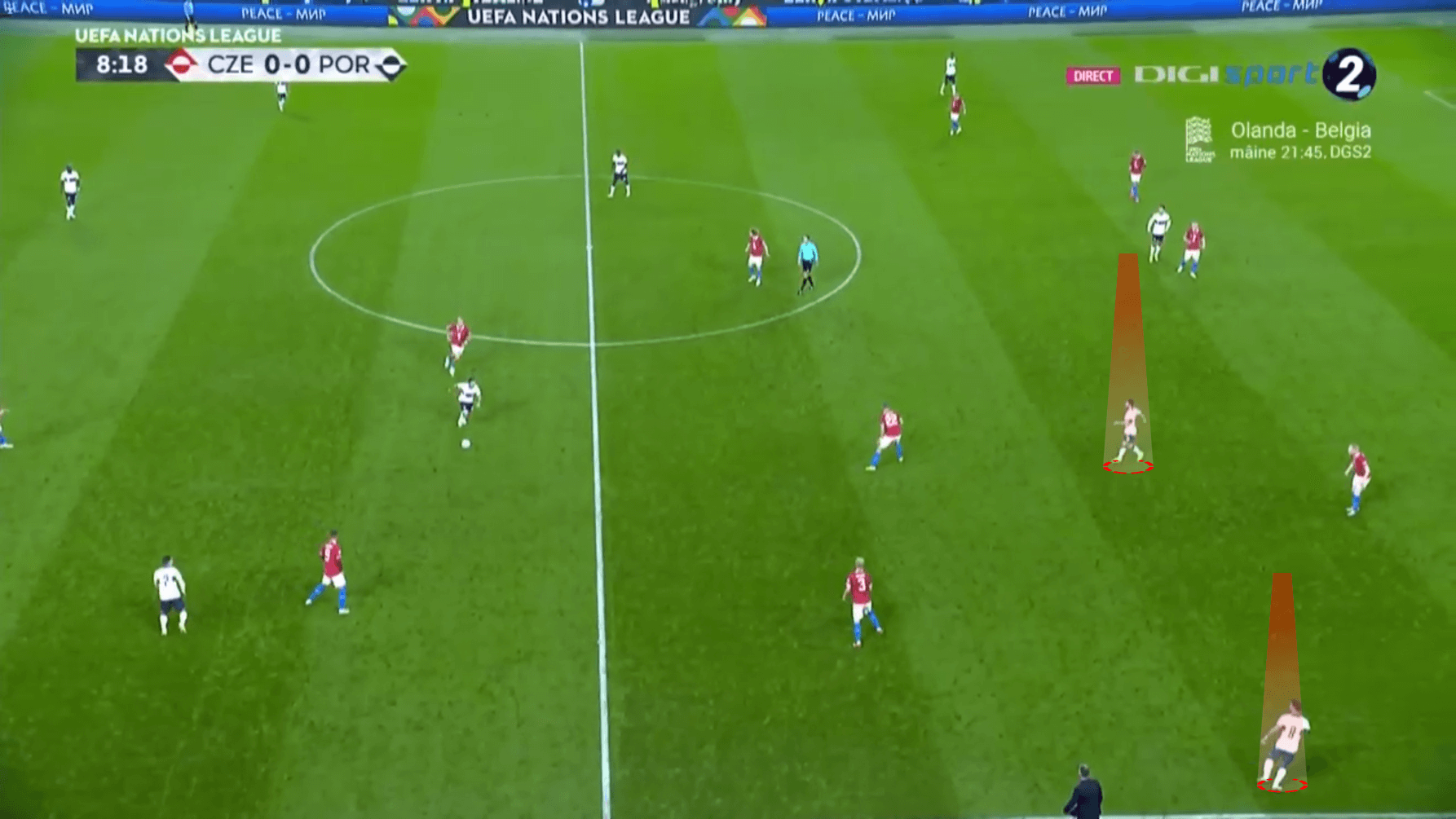
These overloads and exchanges of channels on the right are seen also in the final third, where the right-back makes himself vital with his runs to the box, thanks to the way Portugal pin the defensive line. The first goal was scored because of Bernardo getting deep and passing it to Dalot who can then carry the ball forward before playing to Bruno who crosses it immediately after receiving.
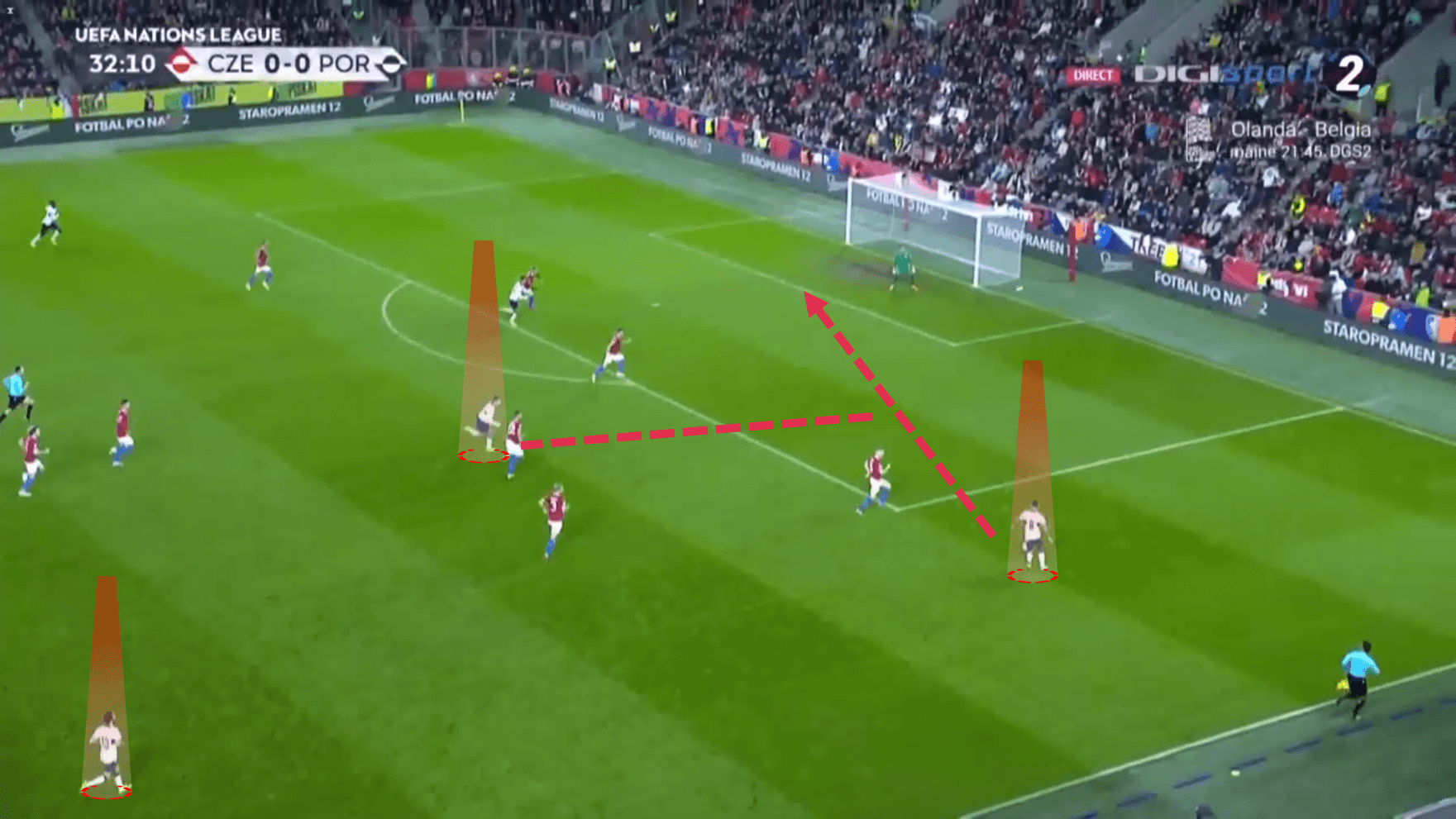
Fernando Santos’ team tries to score goals in many ways — one of them being a reliance on the goalscoring ability of Cristiano Ronaldo inside the box, so crosses can be a constant way of breaking the deadlock, as they have players with great crossing technique such as Rafael Leão, Nuno Mendes or João Cancelo.
However, there is a method Portugal has implemented to find players arriving at the box and anticipating outswing crosses, either high or low. When they have settled in the final third of the pitch, normally Rúben Neves is the player that dictates the turn and changes the ball quickly to the weak side, where the ‘10’, full-backs or winger immediately look to pass it to the box.
Movements off the ball are also very important in this goalscoring tactic, as sometimes the ‘10’ is the one that goes in or Cristiano might leave his zone to make space for others. In the figure below, we can see Bruno is the one taking Ronaldo’s spot to score a tap-in.
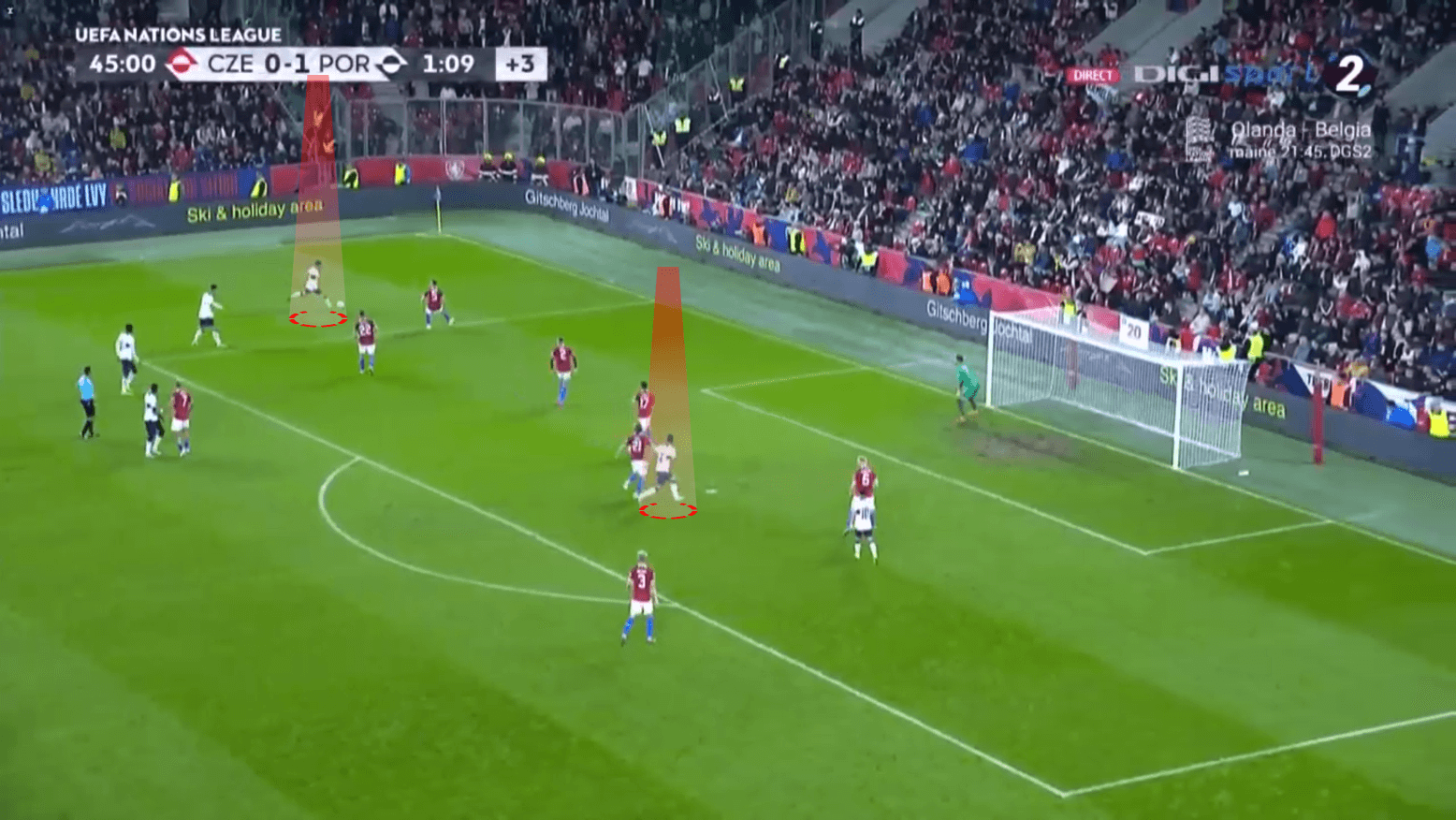
Portugal like to rely also on the long shooting ability that most of the players in the squad have. Players like Bernardo Silva, Bruno Fernandes, João Cancelo or Rúben Neves often try to score from outside the box.
Defensive phase
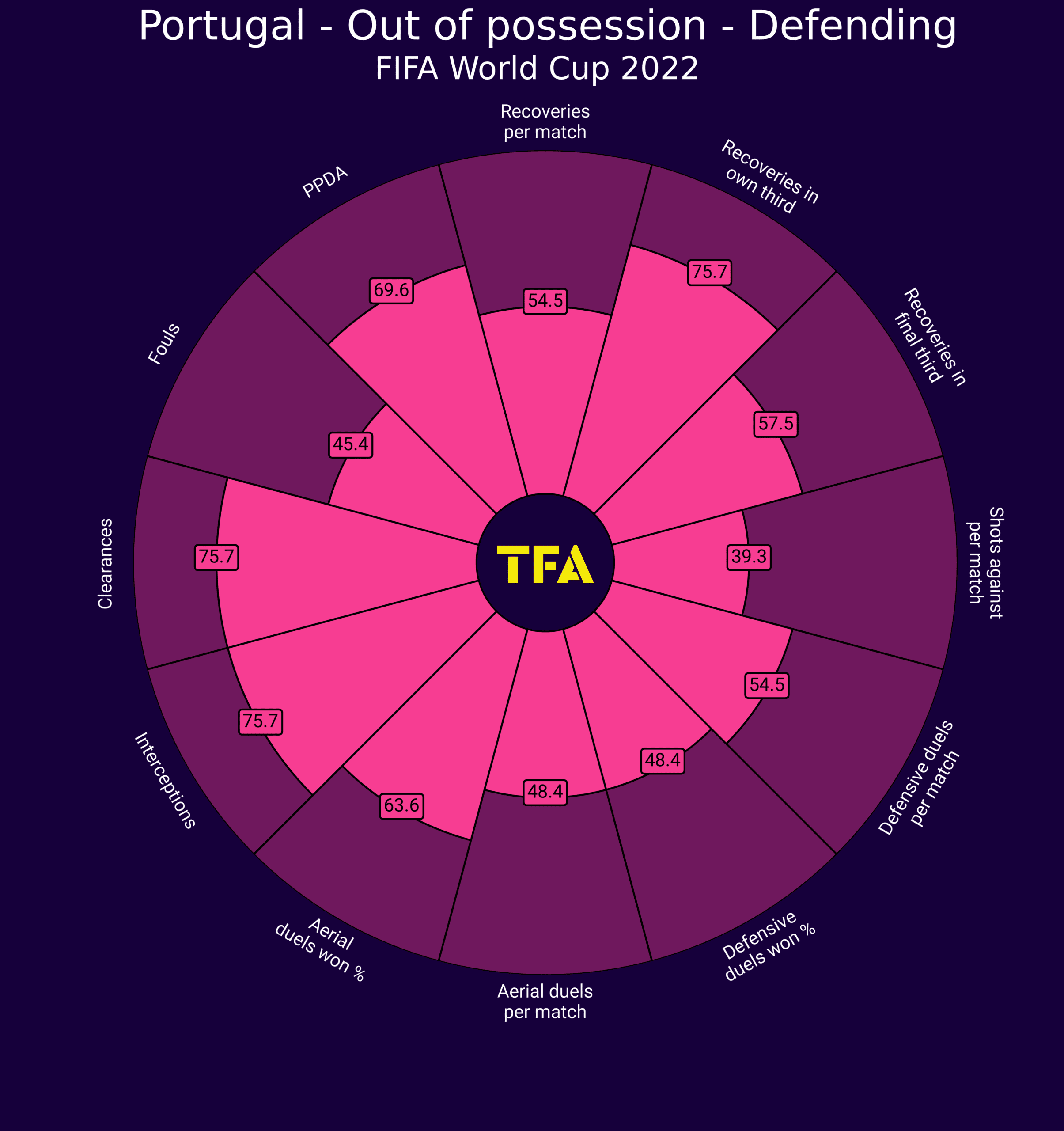
Fernando Santos’ team like to sit in a rigid mid-block against highly possession-based sides, looking to frustrate them as they would dominate the ball but create very few chances. They also like to go a bit higher if the opposition is trying to attract them, where they aggressively go to tightly mark the player on the ball.
This mid-block is formed in a 4-1-4-1 where Rúben Neves stays behind the midfield line and in front of the back-four to avoid free players that like to float between these two lines. His role is to make the team more compact — not allowing a player to turn there is key.
Bruno Fernandes man-marks the rival ‘6’ to close down that circuit of passes between centre-backs and pivot; William Carvalho occasionally jumps off his line and wingers mark zonally, leading to a pressing trap in the wide areas, where full-backs make themselves very important, especially Nuno Mendes and his big ball-winning attributes.
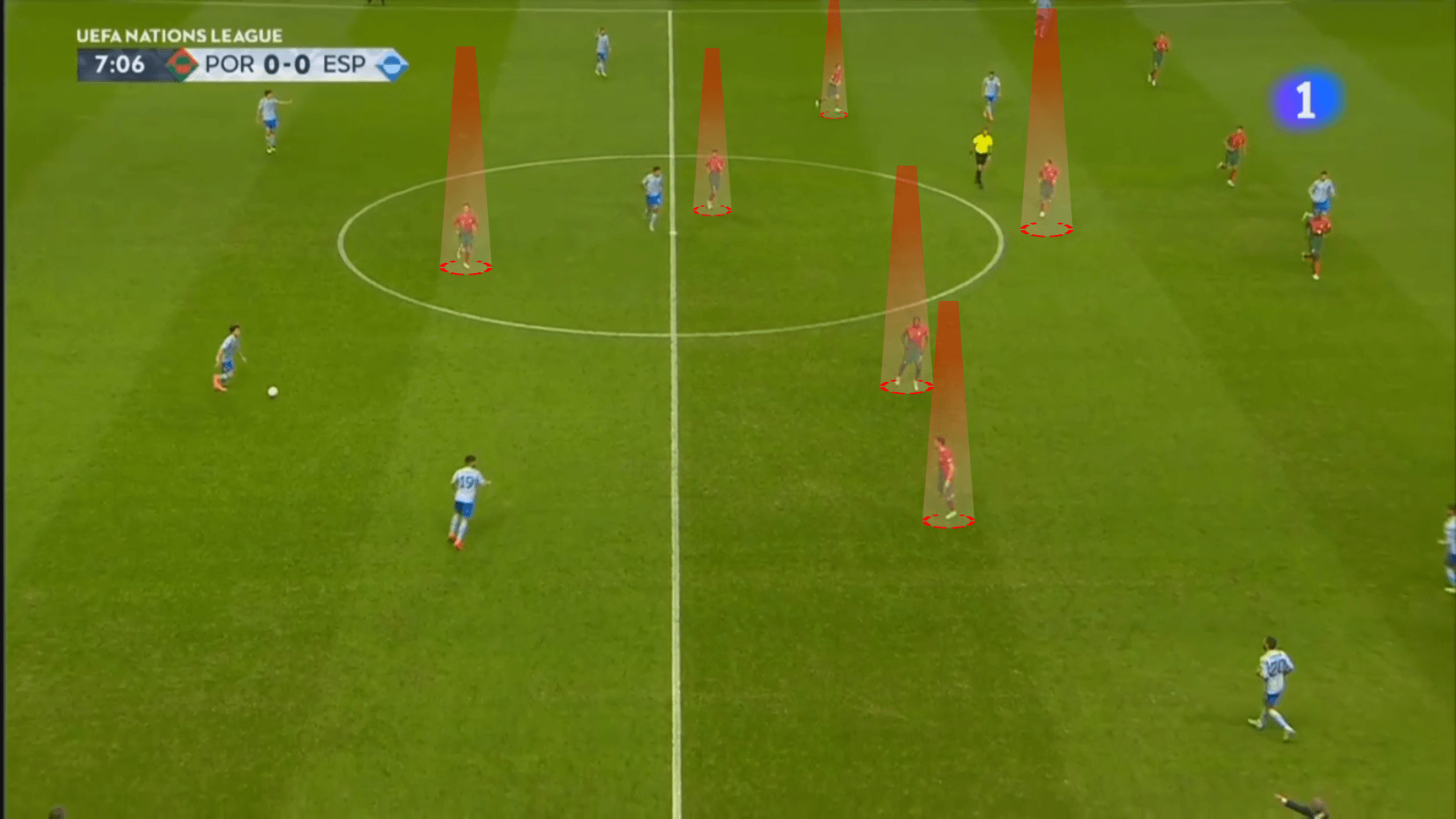
When they are attracted by the rival, Carvalho’s defensive ability to suffocate players becomes crucial and the intensity from the players to try and rob the ball very high on the pitch gets faster second by second. Bruno Fernandes places himself through the middle, being the man that recognises triggers and communicates with everyone to make a great input for the pressing system.
As we can see in the figure below us, Portugal like to be very aggressive if the opponents try to stay for a long time with the ball in their own third, trying to attract them to then attack spaces. Left-winger, in this case, Diogo Jota, goes inside to mark the man on the ball, as well as Bernardo Silva to overload midfield and force them to play through wide zones, where they are very good at winning the ball back.
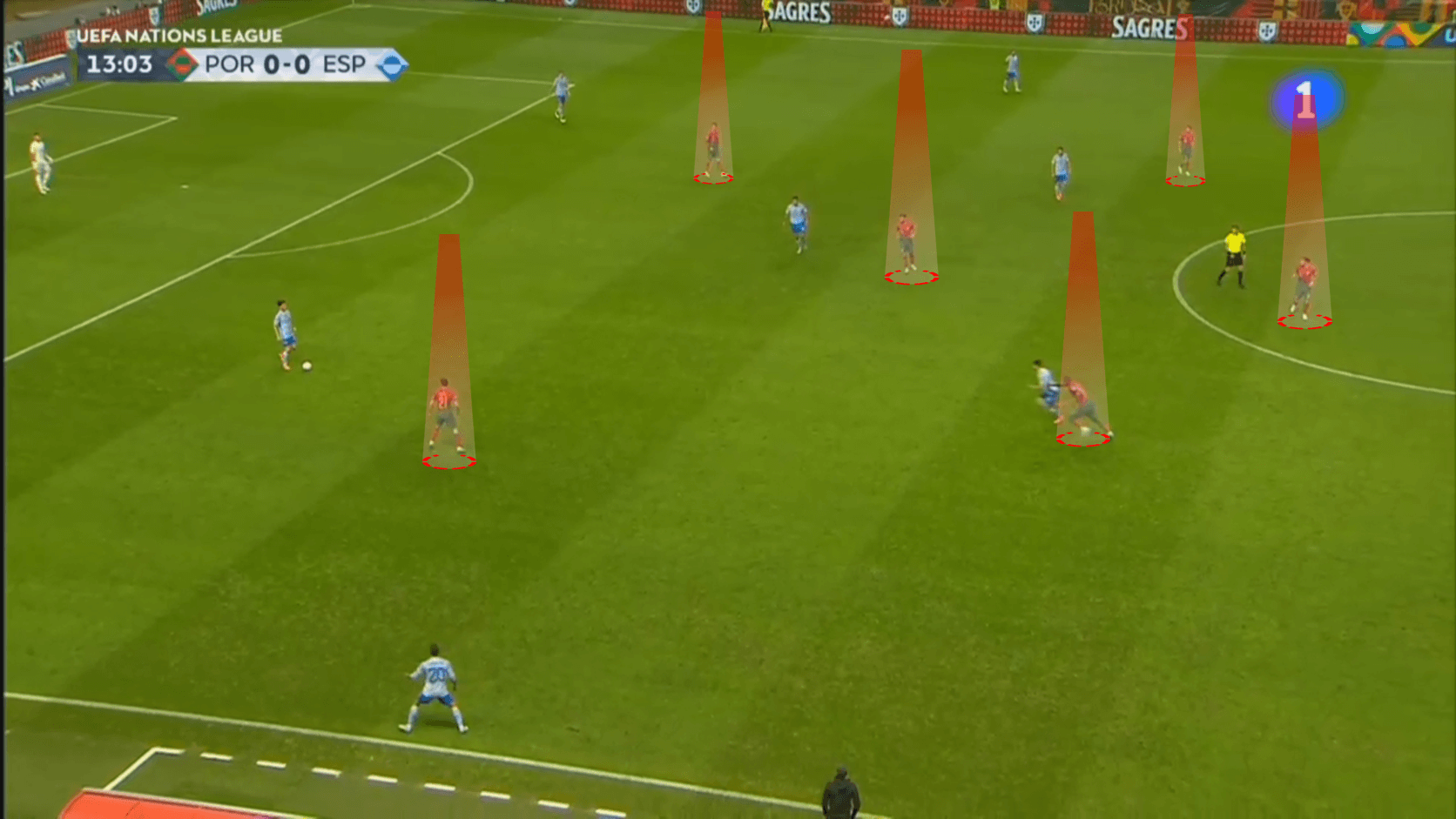
Another good example is this one against Spain, where goalkeeper Unai Simón has stayed a long time with the ball, and Cristiano Ronaldo goes to mark him tightly and even manages to earn a corner for his team. Again, we see that William Carvalho marks his rival very tightly, and even Rúben Neves gets very high up to engage in the first stage of the rival’s build-up.
Transitions
Portugal like to put emphasis on attacking transitions, as players like Rafael Leão and Cristiano Ronaldo are very threatening players running into space, while they also have orchestrators such as Bernardo, Bruno or Rúben Neves.
This picture shows us how they usually like to execute transitions: A run on the left and a long pass through the middle, mainly struck by Neves or Bruno Fernandes. Cristiano Ronaldo or Diogo Jota (LW) are the predominant players who are targeted in these situations. This transition started on the left, and the winger is asked to carry the ball forward rapidly and directly.
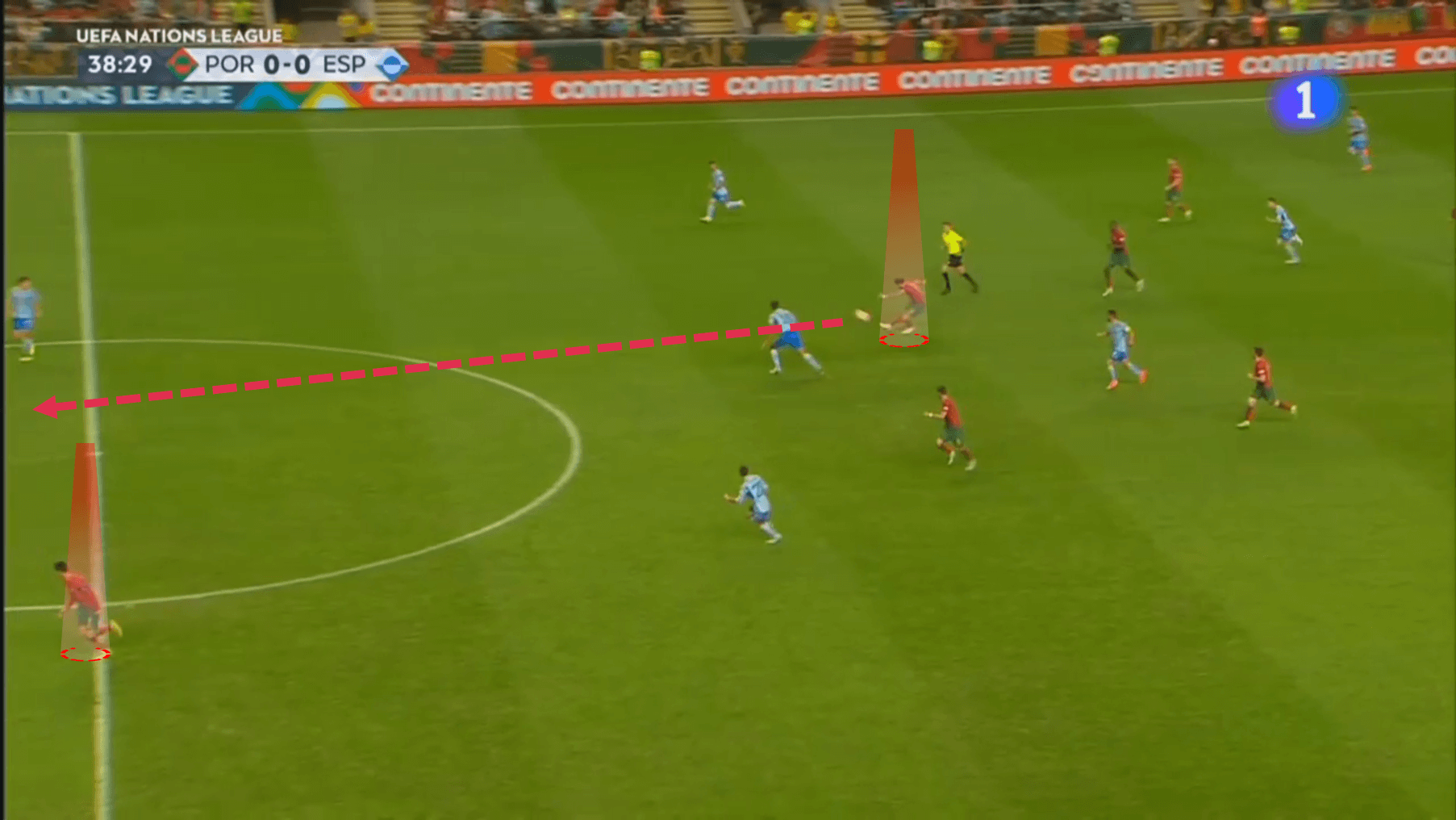
In defensive transitions, Portugal make really good exchanges of blocks between the high and the mid-low ones, with the great work of Neves and Carvalho to protect the central areas, and the intense work rate the wingers bring to the team to help the full-backs. Normally, you don’t see Santos’ team wide open in transition, as players understand tactically where they have to stay if it is a 3-2 or 2-3 with the right-back being part of those trios.
Defenders
The goalkeeper position is fantastically covered as Diogo Costa will surely start but José Sá and experienced Rui Patrício could wait for their chance on the bench, as well as this, Patrício’s mental character is going to help the team in many ways.
In the centre of the defence, Santos has difficult choices to make, as Pepe and José Fonte, at 39 and 38 years of age, respectively, are still good options, especially the Porto defender. However, young players such as Tiago Djaló or David Carmo deserve a chance to be there too alongside Rúben Dias. The full-backs are well covered with players like Diogo Dalot and Cancelo on the right, and Nuno Mendes on the left.
Midfielders
Portugal has developed some serious midfield talents over the years since their setbacks in major tournaments. In João Palhinha and the trusted Rúben Neves, they have two amazing players to play deep as a pivot but experienced William Carvalho or Vitinha and Matheus Nunes show up as the young starlets that could bring even more to the box-to-box role. Bruno Fernandes, João Mario and João Félix are three great names to play in the ‘10’ role.
Attackers
Besides the injury Diogo Jota has suffered that should keep him out of the 2022 World Cup, Portugal have marvellous options upfront to play in an attacking trio that looks incredible with Cristiano Ronaldo alongside wingers Bernardo Silva, Ricardo Horta or Rafael Leão. They will surely be joined by Gonçalo Guedes or André Silva to replace Jota.
Key player
In his last World Cup, Cristiano Ronaldo has a big mission to fulfil in his career: to try and win the most important trophy any player could have in his cabinet. He’s not living his best moment at Manchester United right now, but in the National Team, all can change radically in a context in which he’s the leader, captain and a vital player in the attacking phase, commanded by him with young gems at his back.
His weaknesses are well-documented, with Ronaldo offering his side very little without the ball. However, if Portugal can successfully set up plenty of goalscoring opportunities for the 37-year-old in high-value shooting positions, Ronaldo could still be an extremely valuable asset in Qatar.
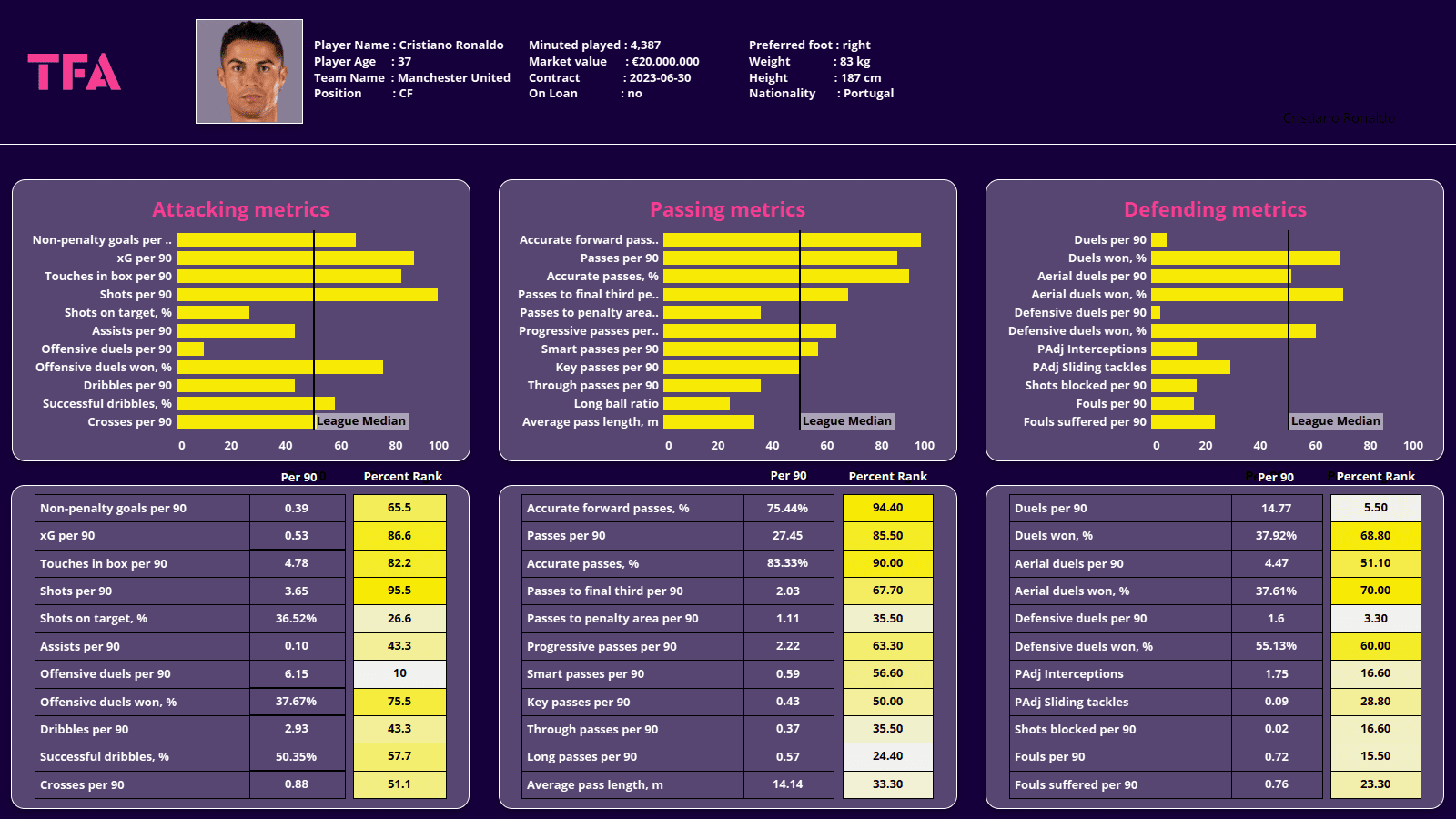
Tournament prediction
Though not playing the most entertaining football, Portugal have a brilliant and talented squad all around the pitch. Teams like theirs often go under the radar because they have been lacking dynamic and intensity during the qualifiers or the Nations League.
However, the presence of great players in each line is always a boost for them and concerning for rivals, so Portugal can’t be ruled out of going all the way in this tournament, though they’ll undoubtedly need to up their recent performance levels both as a team and as individuals for their key players in order to stand a chance of competing with the best of the best this winter.

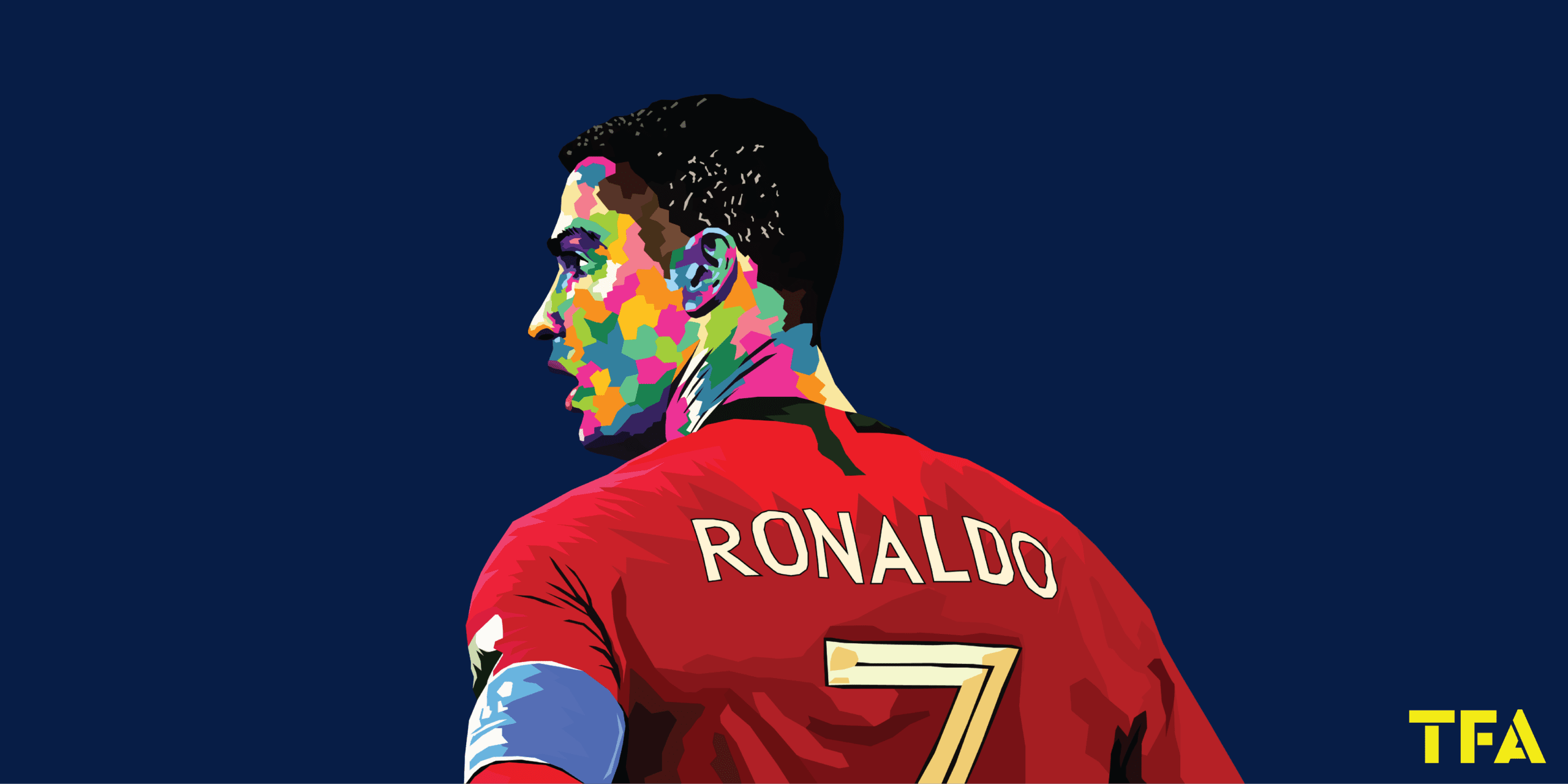



Comments